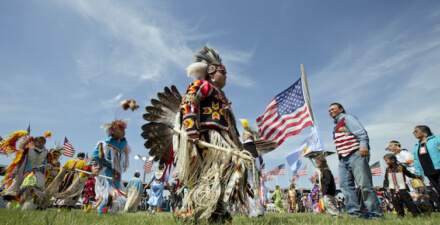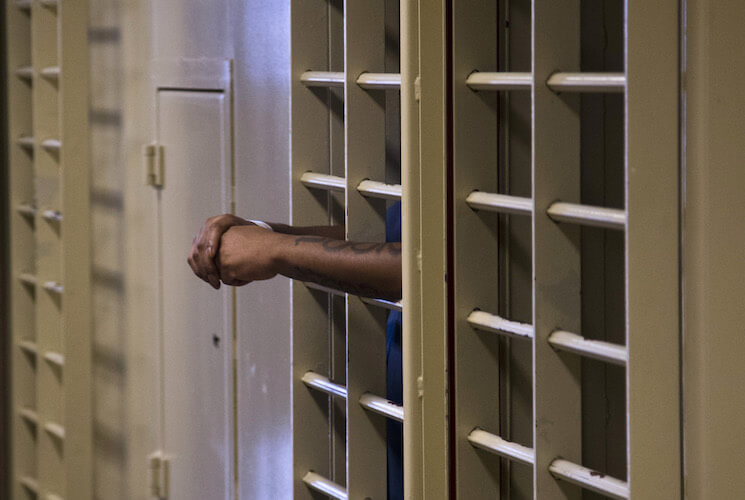Prisoner re-entry in Native American communities offers lessons of resilience and nationwide policy solutions

This essay is part of Vision 2020: Evidence for a stronger economy, a compilation of 21 essays presenting innovative, evidence-based, and concrete ideas to shape the 2020 policy debate. The authors in the new book include preeminent economists, political scientists, and sociologists who use cutting-edge research methods to answer some of the thorniest economic questions facing policymakers today.
To read more about the Vision 2020 book and download the full collection of essays, click here.
Overview
Half of all tribal reservations in the United States have unemployment rates higher than 50 percent, and nearly all have poverty rates of more than 40 percent, with their incarceration patterns 44 percent higher than national averages.1 Scores of men and women have been removed from their communities by the criminal justice system, and the adverse effects of prisoner re-entry have been immediate in tribal communities.
Despite dealing with these consequences of significant and overlapping economic and social inequalities for generations, tribal reservations and the individuals who call these areas home are examples of living resilience. Their resilience manifests in the ability to overcome great adversity to teach their children the traditions passed down to them from their elders, honor their obligations to their families and communities, and steward their local environments.
As a Yurok sociologist, I offer the experience of my own tribal reservation, the Yurok Indian Reservation in northwestern California, and the experience of Indian Country at large as an opportunity to devise and extrapolate effective strategies for prisoner re-entry in communities across the country. Tribal Americans are the first inhabitants of our country, and their ability to persist despite centuries of economic and social inequality is evidence of their tenacity and resilience. Better understanding the process of resilience in these communities affected by mass incarceration, substance use, and poverty could unlock similar strategies for use in areas with comparable obstacles, such as other rural parts of the country, low-income neighborhoods, and other communities.
Learning how tribal members thrive on remote reservations despite their scant resources and high substance abuse rates can shed light on how to intervene in the opioid crisis that is devastating so many rural, underresourced communities around the country. Going further, understanding prisoner re-entry from a rural perspective will help adapt existing community reintegration policies to better meet the needs of those living far from public transportation, formal employment, public housing, and other key supports for helping offenders get back on their feet post-incarceration.2 Finally, finding a way to revitalize stagnant reservation economies could shed light on how to do so in other communities affected by industrial decline.
In these ways, Indian Country has much to teach the rest of the United States when it comes to successfully intervening in cycles of adversity. Yet sizable public investments and increased legislative support must first be secured to maximize these lessons. Toward those ends, I introduce three noteworthy solutions for policymakers to support: the importance of investing in rural data infrastructure; reshaping the criminal justice system to re-emphasize rehabilitation over punishment in the form of therapeutic jurisprudence; and expanding the mental health and dual diagnoses services that are available in rural areas.
Data infrastructure
Data infrastructure matters because there can be no policy intervention without first establishing the baseline and scope of a problem. One such example includes the epidemic of missing and murdered indigenous women and girls across the country. Documentaries such as this river and Finding Dawn and popular films such as Wind River speak to the grave miscarriages of justice that take place far too often on tribal lands, where indigenous women are up to 10 times more likely to be victims of a violent assault than their nonindigenous counterparts.
Scholar-activists such as Annita Lucchesi, director of the Sovereign Bodies Institute and creator of the database on missing and murdered indigenous women and girls, and the Urban Indian Health Institute have each made great inroads to document the scope and breadth of this tragic phenomenon.3 In spite of their contributions, such data-collecting efforts are far too often stymied by national and local law enforcement agencies that refuse to work in good faith with tribal bodies to share data on their citizens. The Freedom of Information Act exists for a reason, but Freedom of Information Act requests add unnecessary and even damaging time to the search for missing and murdered indigenous women and girls, and risk further victimizing those who are missing and murdered, as well as their families, by preventing tribes from accessing essential records on their behalf.
Without proper data on their missing and murdered citizens, tribal nations are greatly limited in their capacity to intervene in the violence and adversity that claims the lives of their mothers, daughters, aunties, and sisters well before their time. It is the responsibility of both policymakers and the criminal justice system to honor the sovereignty of tribal nations as partners in seeking justice in Indian Country through full and transparent cooperation, from the reporting of a crime through its investigation and prosecution.
Even more so, resources and funding must be allocated to tribes and their neighboring county jurisdictions to design, implement, and expand their data-collection infrastructure. Piloting these strategies in tribal communities could shape efforts to build similar mechanisms in rural areas across the country, areas that are notoriously underresourced with regards to data collection.4
Criminal justice
Just as we build the tools necessary to track the victims of violent crime in tribal communities, we must also design our policy interventions to meet the needs of tribal offenders. These individuals have indeed committed crimes, but more often than not, they also have been victims of violence and trauma themselves. For Native men in particular, one must take into account that they suffer trauma at far disproportionate levels compared to other groups, but we have yet to recognize this in theory or policy.5
American Indian and Alaskan Native, or AI/AN, men experience more disparities than any other group, including increased risk of chronic health conditions, accidental death, and homicide. Their suicide rate outpaces that of any other group from adolescence to middle age.6 Only 50 percent of American Indians graduate high school, with less than one in three American Indian men graduating in areas with large native populations, such as the Dakotas.7 American Indian men are overrepresented in the criminal justice system, and Yurok men in particular are 11 times more likely to go to jail than the average American.8
Despite such a long list of adversities, “AI/AN men persist,” says education psychologist Leah Rouse, associate professor and Eleta Quinney Scholar at the University of Wisconsin, Milwaukee’s School of Education, and their resilience cannot be understated.9 Tribal men overcome their traumas to honor their obligations to their families and communities. My work with tribal fathers with criminal records speaks to the deep involvement and intense meaning that they derive from their roles as providers and teachers. In spite of their pro-work orientations, they are limited in their capacity to find work by their criminal histories and struggles with substance abuse, and these constraints are further exacerbated by the slack labor market in which they find themselves.10
For former offenders, finding work is first a process of getting sober. Even if they abstained from substances for the duration of their sentence, up to 90 percent of repeat offenders struggle with chronic substance use.11 Those courts that best support their efforts to get “clean and sober” employ a therapeutic jurisprudence model through holistic case management that centers on framing those under supervision as assets rather than liabilities.12
California is leading the way with such efforts in the form of joint jurisdiction courts. The Yurok Tribe is partnering with the surrounding counties of Humboldt and Del Norte to create courtrooms where tribal judges work with county judges to support offenders through re-entry by offering Wellness Courts to support recovery, accept in-kind child support in the form of traditional food gathering and subsistence hunting, and offer culturally adapted batterer’s intervention programming. Those jurisdictions that have partnered with tribal bodies to shepherd their members through the criminal justice system are thriving.13
Even still, we need more county jurisdictions that are willing to pioneer these efforts alongside increased funding to help them do so. Long term, federal policymakers could directly expand tribal court oversight through executive orders and bills that emulate the Indian Child Welfare Act and the Violence Against Women Act by placing jurisdiction over injustices committed against tribal peoples directly into the hands of these sovereign nations. Such vital legislation has previously protected thousands of Americans and greatly enhanced the ability of tribal courts to safeguard and support their citizens.
By spearheading the expansion of tribal jurisdictions, policymakers can support these courts to pioneer effective criminal justice reform ripe for replication. In this way, those communities that also are plagued by mass incarceration will benefit from the strategies formulated by tribal courts as they facilitate the process of successful prisoner re-entry.
Mental health and dual diagnoses services
A key component of supporting “returners” as they navigate life post-incarceration is addressing their needs in a holistic manner that affirms them as a whole person. Many offenders must meet their mental health needs before they can find work and support their families, and that often means seeking drug rehabilitation treatment. My research shows that legacies of adversity cluster on reservations, such that those who live there are much more likely to be exposed to adverse experiences across the course of their lives. Such trauma can have lifelong implications and, when combined with substance use, can dramatically reduce the ability of an individual to function in mainstream society, let alone gain and maintain formal employment.14
If policymakers and civic leaders are to intervene in cycles of trauma and addiction that span generations, then they must greatly augment the existing mental healthcare system in this country. Rural areas have few mental health resources and would particularly benefit from an increased investment in dual diagnoses treatment centers that have the capacity to support individuals with co-occurring disorders such as post-traumatic stress disorder, depression, and drug and/or alcohol dependence.15
Beyond the significant human toll, these conditions deprive the nation’s workforce of billions of dollars in lost productivity each year.16 Integrated mental and substance abuse care facilities that have the capacity to treat co-occurring mental health conditions and addiction comprise only a fraction of available treatment options in this country, and policymakers must budget accordingly for the expansion of such services in rural and urban areas alike.17 Mental heath is a right, not a privilege. It is high time policymakers enshrined this ethos through effective legislation and investment.
Native American communities as sources of resilience
Indigenous peoples are the original inhabitants of every landscape in the United States and the vitality of their communities are a direct reflection of the health of the nation at large. Described as the “miner’s canary,” tribal reservations and their off-reservation networks are a pulse point from which to observe the historical and present-day legacies of oppression and violence in the United States.18
There are harsh conditions that shape life on many reservations. These are a direct reflection of the historical trauma that accompanies life on tribal lands. Eduardo Duran and his co-authors of “Healing the American Indian Soul Wound,” coin the term soul wound to refer to the traumas that cannot heal in one generation and persist through to the next.19 Such trauma is cumulative and concentrated in communities marked by cumulative adversity.20
The soul wound also is known more recently as intergenerational trauma, historical trauma, and post-traumatic stress disorder—all academic names for a phenomenon that has been acknowledged for centuries in Native communities.21 Even for those who did not perish from physical contact with Europeans and their diseases beginning in the 15th century or the genocide and slavery that followed, the trauma of these events and others, such as the forced removal of Indian children to residential boarding schools and the termination of tribal sovereignty in the 1950s, all accumulate over time, leaving the survivors with guilt and unresolved mourning.22
Losses of such magnitude are expressed at the epigenetic level, whereby extreme stress can change the structure of human DNA such that the trauma experienced by past generations is transmitted down to their descendants.23 Such DNA testing confirms what tribal communities have long known to be true—the higher rates of alcoholism, suicide, and other chronic health conditions such as diabetes and heart disease that plague Native American families represent the residue of past traumas manifesting in present-day symptoms.24 Thankfully, because “the explanations of the soul wound are centuries old,” so too are its solutions.25
Without trauma, there can be no resilience. Resilience is not a trait, but rather a dynamic process that speaks to the ability to adapt to adversity and “bounce back” from stress and trauma.26 In Native communities, the need for resilience has surfaced time and time again, as “perfectly normal people respond to an abnormal history,” writes Martin Brokenleg, a Rosebud Sioux and a professor of Native American Studies and chair of the Department of Sociology and Social Work at Augustana College.27 In this way, indigenous peoples have much to teach us about the process of resilience. By investing in the strategies of resilience derived from tribal communities, policymakers can emulate these mechanisms for successful intervention in similarly disadvantaged communities.
Download FilePrisoner re-entry in Native American communities offers lessons of resilience and nationwide policy solutions
Conclusion
Ultimately, while we as indigenous peoples live in communities that deal with high crime, epidemic substance use, and a host of other negative outcomes on a daily basis, we are still here, and our very existence is a reflection of our resilience over time. We are the epitome of survival, and we draw on our deep knowledge base as this country’s original caretakers to thrive despite many obstacles otherwise.
Even with our resilience, however, we are in desperate need of enhanced infrastructure and increased investment to expand our efforts to heal the wounds left by generations of trauma and oppression. The rural areas that many of us call home are the least prepared to meet our needs despite a sincere desire to do so, yet this could easily be ameliorated through legislative and monetary investments. We have the answers and the ways of knowing that we need to heal ourselves, but we need the funding and the infrastructure necessary to do so.
Specifically, by increasing the resources available for rural data collection and dual diagnosis mental health facilities, as well as expanding the jurisdictions of tribal courts to better allow them to directly meet the needs of their citizens, policymakers stand to greatly augment their own resources for intervening in comparable adversities in communities around the country. Investing in our vitality as indigenous peoples is the first step to identifying those strategies of resilience needed to restore the health of communities shaped by inequality. ‘Wokhlew’ (“thank you” in Yurok) for your consideration.
—Blythe George is a member of the Yurok Tribe of California and a post-doctoral sociologist at the University of California, Berkeley.
End Notes
1. Randall K.Q. Akee and Jonathan B. Taylor, Social and Economic Change on American Indian Reservations: A Databook of the US Censuses and the American Community Survey 1990–2010 (Sarasota, FL: The Taylor Policy Group, Inc., 2014); Eric Henson, The State of the Native Nations: Conditions Under U.S. Policies of Self-Determination (New York: The Harvard Project on American Indian Economic Development, 2008).
2. Christy Visher and Jeremy Travis, “Transitions From Prison To Community: Understanding Individual Pathways,” Annual Review of Sociology 29 (2003): 89–113; Christy Visher and others, “Baltimore Prisoners’ Experiences Returning Home” (Washington: Urban Institute Justice Policy Center, 2004); Demelza Baer and others, “Understanding the Challenges of Prisoner Reentry: Research Findings from the Urban Institute’s Prisoner Reentry Portfolio” (Washington: Urban Institute Justice Policy Center, 2006); David Harding and others, “Making Ends Meet after Prison: How Former Prisoners Use Employment, Social Support, Public Benefits, and Crime to Meet their Basic Material Needs.” Working Paper Series #11–25 (National Poverty Center, 2011).
3. Annita Lucchesi and Abigail Echo-Hawk, “Missing and Murdered Indigenous Women & Girls: A Snapshot Of Data From 71 Urban Cities In The United States” (Seattle, WA: Urban Indian Health Institute, 2019).
4. Ralph Weisheit and L. Edward Wells, “Rural Crime and Justice: Implications for Theory and Research,” Crime and Delinquency 42 (3) (1996): 379–397.
5. Leah Rouse, “American Indians, Alaska Natives, and the Psychology of Men & Masculinity.” In APA Handbook of Men & Masculinities (Washington: American Psychological Association, 2015), pp. 319–337; Eduardo Duran and others, “Healing the American Indian Soul Wound.” In International Handbook of Multigenerational Legacies of Trauma (Berlin: Plenum Press, 1998), pp. 341–354.
6. Rouse, “American Indians, Alaska Natives, and the Psychology of Men & Masculinity.”
7. Susan C. Faircloth and John W. Tippeconnic III, “The Dropout/Graduation Rate Crisis Among American Indian and Alaska Native Students: Failure to Respond Places the Future of Native Peoples at Risk” (Los Angeles: The Civil Rights Project at UCLA, 2010).
8. Stephanie Beran, “Native Americans in Prison: The Struggle for Religious Freedom,” Nebraska Anthropologist (2005): 46–55.
9. Rouse, “American Indians, Alaska Natives, and the Psychology of Men & Masculinity,” p. 334.
10. Matthew S. Carroll and others, “A Response to “Forty Years of Spotted Owls? A Longitudinal Analysis of Logging Industry Job Losses,” Sociological Perspectives 42 (2) (1999): 325–33; Tim Slack and Leif Jensen, “Employment Adequacy in Extractive Industries: An Analysis of Underemployment, 1974–1998,” Society & Natural Resources 17 (2) (2004): 129–46; Humboldt County Office of Economic Development, “Humboldt Timber Industry: Down But Not Out,” (2007); Jeffrey Stier, “Technological Adaptation to Resource Scarcity in the U.S. Lumber Industry,” Western Journal of Agricultural Economics 5 (2) (1980): 165–75.
11. Shadd Maruna, Making Good: How Ex-Convicts Reform and Rebuild their Lives (Washington: American Psychological Association, 2001).
12. Bruce Winick and David B. Wexler, “The Use of Therapeutic Jurisprudence in Law School Clinical Education: Transforming the Criminal Law Clinic,” Clinical Law Review (13) (2006): 605–632.
13. Henry Gass, “Native Justice: How Tribal Values Shape Judge Abby’s Court,” The Christian Science Monitor, March 27, 2019; Geoffrey Riley, John Baxter, and April Ehrlich, “Yurok Tribal Court Featured In PBS Documentary,” Jefferson Public Radio, October 4, 2017.
14. Robert F. Anda and others, “The Enduring Effects of Abuse and Related Adverse Experiences in Childhood: A Convergence Of Evidence From Neurobiology and Epidemiology,” European Archives of Psychiatry and Clinical Neuroscience 256 (2006): 174–186; Vincent J. Felitti and others, “Relationship of Childhood Abuse and Household Dysfunction to Many of the Leading Causes of Death in Adults: The Adverse Childhood Experiences (ACE) Study,” American Journal of Preventative Medicine 14 (4) (1998): 245–258; Jon D. Kassel, ed., Substance Use and Emotion (Washington: American Psychological Association, 2010).
15. Linda Burton and others, “Inequality, Family Processes, and Health in the “New” Rural America,” American Behavioral Scientist 57 (8) (2013): 1128–51.
16. Debra Lerner and others, “Unemployment, Job Retention, and Productivity Loss Among Employees With Depression,” Psychiatric Services 55 (12) (2004): 1371–78; Jean-Pierre Lépine and Mike Briley, “The Increasing Burden Of Depression,” Neuropsychiatric Disease and Treatment 7 (1) (2011): 3–7.
17. Mark P. McGovern and others, “Dual diagnosis capability in mental health and addiction treatment services: an assessment of programs across multiple state systems,” Administration and Policy in Mental Health 41 (2) (2014): 205–14.
18. C. Matthew Snipp, “Sociological Perspectives on American Indians,” Annual Review of Sociology 18 (1992): 351–71; Felix Cohen, “The Erosion of Indian Rights, 1950 – 1953: A Case Study in Bureaucracy,” Yale Law Journal (1953).
19. Duran and others, “Healing the American Indian Soul Wound.”
20. Robert Sampson, “Urban Sustainability In An Age Of Enduring Inequalities: Advancing Theory And Ecometrics,” PNAS Early Edition, Proceedings of the National Academy of Science (2017),:1–6.
21. Duran and others, “Healing the American Indian Soul Wound”; Martin Brokenleg, “Transforming Cultural Trauma into Resilience,” Reclaiming Children & Youth 21 (3) (2012) 9–13.
22. Colin G. Calloway, First Peoples: A Documentary Survey of American Indian History, 4th ed. (Boston: Bedford/St. Martin’s, 2011); Benjamin Madley, An American Genocide: The United States and the California Indian Catastrophe (New Haven, CT: Yale University Press, 2016); K. Tsianina Lomawaima, “Educating Native Americans.” In James Banks and Cherry Banks, eds., Handbook of Research on Multicultural Education (San Francisco: Jossey-Bass, 2004), pp. 441–490; Kenneth R. Philp, Termination Revisited: American Indians on the Trail to Self-Determination, 1933–1953 (Lincoln: University of Nebraska Press, 1999); Charles F. Wilkinson and Eric R. Biggs, “The Evolution of the Termination Policy,” American Indian Law Review 139 (1977); Herbert Hendin and Ann Haas, “Suicide and Guilt as Manifestations of PTSD in Vietnam War Veterans,” The American Journal of Psychiatry 148 (1991): 586–91; Edward S. Kubany, “A Cognitive Model of Guilt Typology in Combat-Related PTSD,” Journal of Traumatic Stress 7 (1994): 3–19; Boris Drozdek Wilson and Silvana Turkovic, “Posttraumatic Shame and Guilt,” Trauma, Violence, & Abuse 7 (2006): 122–141.
23. Mary Annette Pember, “Trauma May Be Woven Into DNA of Native Americans,” Indian Country Today, October 3, 2017.
24. Duran and others, “Healing the American Indian Soul Wound”; Brokenleg, “Transforming Cultural Trauma into Resilience.”
25. Duran and others, “Healing the American Indian Soul Wound,” p. 351.
26. Brokenleg, “Transforming Cultural Trauma into Resilience.”
27. Brokenleg, “Transforming Cultural Trauma into Resilience,” p. 10.







